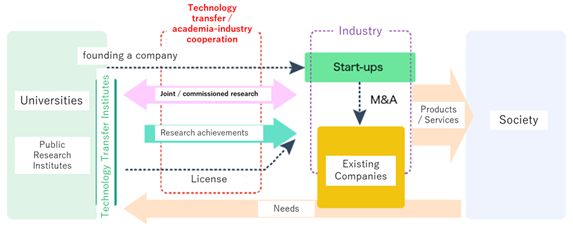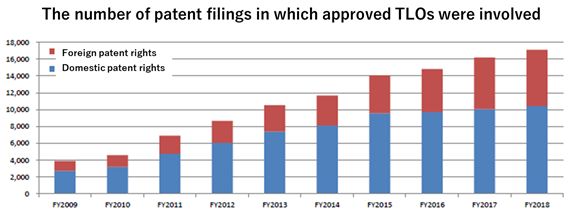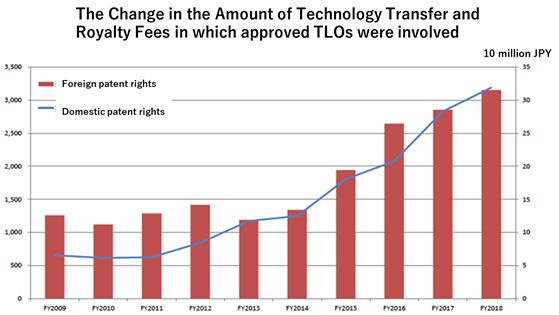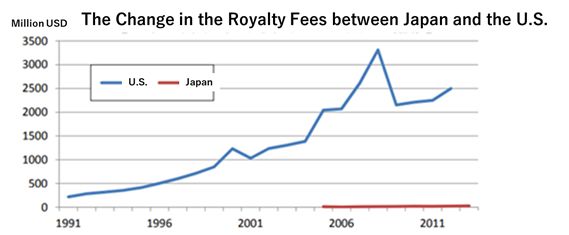It has been many years since the Japanese government started promoting the protection and development of intellectual property as a national strategy under the slogan of "intellectual property-based nation". The field where intellectual property is created has expanded beyond the research and development department of large companies to venture companies and university research institutes. In this article, we will clarify the current status and challenges of technology transfer at Japanese universities, focusing on TLOs (Technology Licensing Organization), and how research results at universities are utilized.
I. What is technology transfer and what are TLOs?
- Definition
Technology transfer is defined for someone or an organization which owns technology to transfer their technology to other people and organizations in the form of technology disclosure, technical guidance, technology transfer, and licensing. The technology transfer agreement is usually signed.
TLO is defined by the Ministry of Economy, Trade and Industry (METI) as follows: a TLO is an organization for the purpose of acquire patent rights of research results of university researchers and transfer them to companies. A TLO plays an intermediary role between industry and academia and is also expected to form the core of industry-university collaboration as the driving force of the "intellectual creation cycle" that creates new industries developed by universities and returns a portion of the profits earned to researchers, thereby generating research funds and bringing about further revitalization of university research.
There are three typical forms of technology transfer. (1) to provide a company with licensing of an intellectual property and knowhow as research achievement by university, (2) to sell and transfer an intellectual property, and etc., and (3) to convey technologies through joint research and technical guidance.
- The backgrounds of establishment of TLOs
The METI stresses the need for TLOs as shown bellows:
- Many research resources are concentrated in universities and other institutions in Japan, and many of the research achievements contain "seeds" for new industries. However, they have not been fully utilized in industry.
- While companies such as manufacturers have their own intellectual property department, which manages patents separately from research departments, there are major problems with the fact that such organizations have not existed in the past in universities. The need for TLOs to patent research results and transfer or license them to companies has come to be recognized.
- Based on the above situation, the Law for Promotion of Technology Transfer to Universities (submitted by the Ministry of International Trade and Industry and the Ministry of Education) was enacted in May 1998 and came into effect in August 1998.
- By establishing TLOs, researchers can devote themselves to research and obtain additional research funding through the patenting and industrialization of their research achievements, which is called the "intellectual creation cycle" system.
- Measures for Approved TLOs
TLOs, which are approved by the Ministry of Education, Culture, Sports, Science and Technology and the METI under the Law for Promoting Technology Transfer from Universities to Industry, are recognized as approved TLOs. The approved TLOs are able to receive the following measures:
- The reduction and exemption of patent fees, etc. (Section 109(2), Section 195(2)2, the Japanese Patent Law)
For conduct of specified university technology transfer operations, the patent fees for the first year to the tenth year and the fees for requesting examination of applications are reduced by one-half.
- Receipt of Bayh-Dole patent (Article 17, the Industrial Technology Enhancement Act)
The transfer or licensing of patent rights, etc. (Bayh-Dole patents) owned by the trustee pertaining to the results of research and development entrusted by the national government does not require the approval of the national government.
- Investment from national university corporations (Article 22 of the National University Corporations Law)
Capital is available from the National University Corporation.
- Implementation of trust business (Article 52 of the Trust Business Act)
The license of the Prime Minister is not required for the implementation of trust business as a specified university technology transfer business.
- Debt guarantee (Article 6 of the University Technology Transfer Promotion Law)
Debt guarantees can be obtained from the Organization for Small and Medium Enterprises and Regional Innovation, Japan for the borrowing of funds necessary for the implementation of the Specified University Technology Transfer Operations.
- Investment in enterprises to which technology is transferred (Article 7 of the Law for Promotion of Technology Transfer at Universities, etc.)
The requirements for investment by Small and Medium Enterprise Investment and Consultation Co., Ltd. will be relaxed for SMEs that have received technology transfer from approved TLOs.
II. Overview of TLO activities
- The following chart shows flows and associations related to technologies among universities, the industrial world and society.
[Note]
The following graph is excerpted from the website, https://unitt.jp/tlo/.

- Changes in the amount of patents and royalty fees
The METI complies and publishes the number of patents and technology transfer which TLOs were involved and royalty fees as shown below. As seen in the following graph, the number of patents and technology transfers is steadily increasing.
[Note]
The following graphs are excerpted from the website of the METI
(https://www.meti.go.jp/policy/innovation_corp/tlo/191211shouninnTLOnokoremadenoseika.pdf).


- Comparison with the United States
As is clear from the above graph, there are great differences in the amount of royalty fees between Japan and the U.S. where licensing is established as a university business. It appears that Japanese TLOs have a lot of room to grow up and expand their licensing business.

[Note] The above graph is excerpted from the survey of University Network for Innovation and Technology Transfer (UNITT)
III. Problems and Solutions
As described above, there is a large difference in experience between the intellectual property licensing business of the U.S. and Japanese universities. In Japan, there are few successful cases, and the technology transfer business is not maturing.
The Japanese government has been also formulating various measures to strengthen industry-university collaboration. For example, the Japanese government has been sending professional advisors on industry-university collaborative intellectual property to universities since 2016 and intellectual property strategy designers to universities since 2019. They have also implemented measures to reduce and exempt patent fees and examination application fees for universities. These measures are expected to improve the weakness of the patent strategy at Japanese universities and the situation where there is a lack of expertise in intellectual property licensing strategies. It is also necessary to focus on cultivation of human resources who are responsible for consistent practice of technology transfer from acquisition of IP rights, financing arrangements, and development of the new markets.
The content of this article is intended to provide a general guide to the subject matter. Specialist advice should be sought about your specific circumstances.
